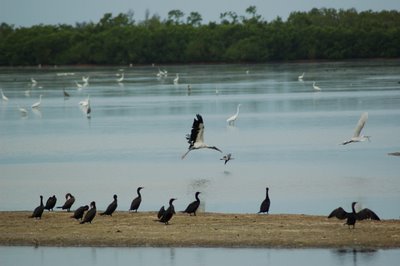
Where the forest meets the sea.
Habitats that lie within the intertidal zone are tough places to make a living. They are constantly changing. An environment that embodies that adage that nothing is consisten, but change. In the intertidal, water levels change, the salinity of the water changes, the presence of high energy waves, variable temperatures and with it, changing amounts of oxygen. All of these variables present special challenges to living things. In the face of such adversity, a group of woody plants has evolutionary risen to these challenges and marked sandy tropical and subtropical intertidal zones as their home turf. We call these spectacular woody trees and shrubs occupying the zone ever shifting between land and sea, mangroves. That habitat they dominate, we call mangals. There are approximately 54 species of mangrove trees throughout the world which belong to 16 different plant families. On Sanibel, there are technically four species of mangrove. We most commonly think of three species, the Red Mangrove, Black Mangrove and White Mangrove. And although not commonly thought of as such, the Buttonwood Tree is also classified as a mangrove.
This photograph is a red mangrove (Rhizophora mangal). This species is characterized by its highly developed system of aerial roots. These roots provide stability for the tree while allowing the roots to not penetrate deeply into the oxygen-depleted muds in which the tree grows. The labyrinth root system provides a structural platform for a myraid of sea life. Coon oysters (Isognomon alatus) commonly grow on aerial roots, and are thickly covering the roots in this picture. Lore has it that these little oysters are so named, because racoons can easily eat them at low tide. In addition to oysters, numerous other species of invertebrate live on and among the roots, including sponges, tunicates, and many crustaceans. Thanks to this structure and many invertebrates, small and/or juvenile fishes are also common in mangal communities... and where there are small fishes, big ones are surely close by, waiting to step up and do their part in the intricate food chain of the inetrtidal.
How lucky that woody trees have been able to slove the problems of living in tropical inertidal zones. They are the foundation of a series of food webs that create the magnificent ecosystems of near-shore marine environments. So, the next time you get a crunchy fried grouper sandwich take a moment to thank a mangrove.

